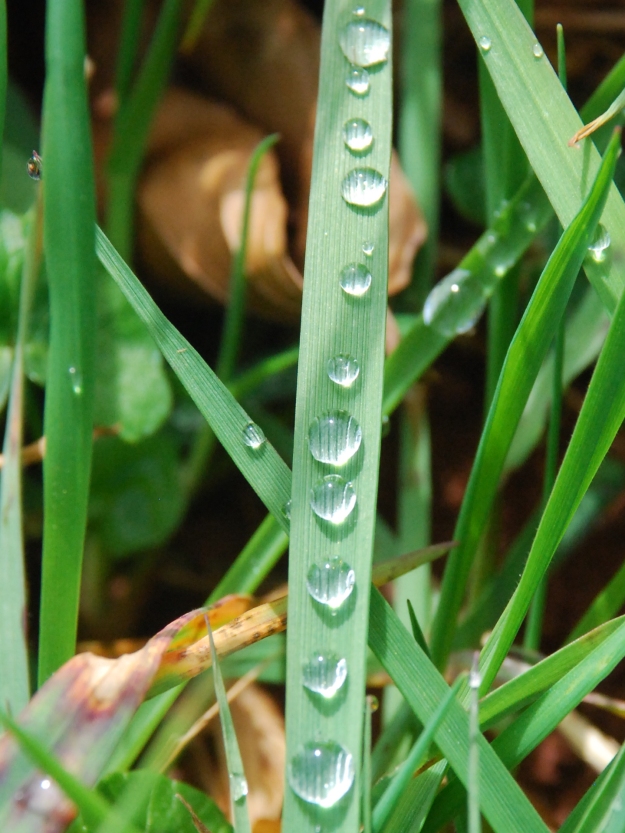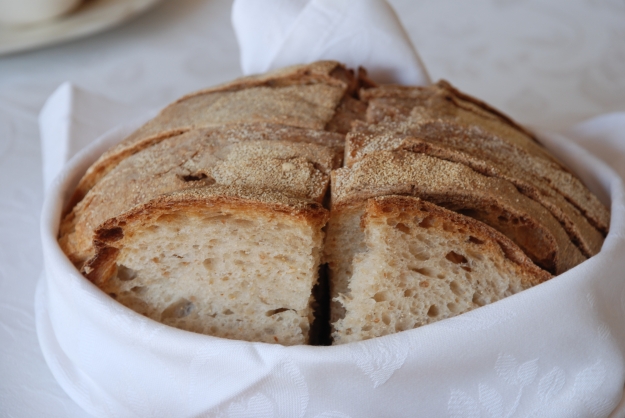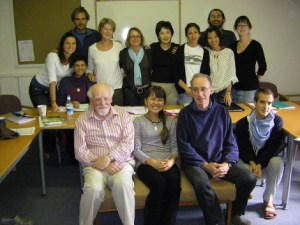Part 2 – The Democratisation of Knowledge:
Collectively Enlivening what and how we know

“To see a world in a grain of sand, and heaven in a wild flower;
Hold infinity in the palm of your hand, and eternity in an hour.”
William Blake, Auguries of Innocence
Continued from Part One: To allow the participants at the ASHA Centre to experience how, or what, it means to them to give the phenomenon of their inquiry their ‘cognitive space’ to become other, and to be seen in process I led them through a phenomenological (or Goethean) study of a Willow tree.
Phenomenology is primarily concerned with how human beings experience the world, and also how we can learn to get to know aspects of the world ‘in terms of themselves’ through our experiencing it, by participating with it in an open, receptive, yet critical way; so as not to constrict or narrow our understanding of the world by squeezing it into our pre-formed (already existing) “rational” assumptions, labels, concepts, or objectifications. It is about being present to ‘what is’, ‘as it is’ – in one’s experiencing of it. Through careful, exact, direct observation, description, and qualitative interpretation, you try to allow the phenomenon to ‘speak for itself’, so that your understanding of it, can be as authentic, and true to the actual phenomenon as possible.
This type of understanding/knowledge is called inter-subjectivity. It transcends the dualism of objectivity (thinking that you are completely separate from something – which is only a rational/intellectual illusion) and subjectivity (thinking that the ‘truth’ of your experience only belongs individually to you, and reduces your experience to just being an ‘interpretation – also an illusion). It confronts, and honours, the paradox of what it means to be human; that we have individual autonomy and free will, yet are also inextricably intertwined with everything that we experience.

Phenomenology takes into account different dynamics of life than are commonly considered in other research methodologies, such as; the whole expressing itself through its part, intrinsic value expressing itself through extrinsic form, the inherent interconnectedness of all life, social and physical; and it includes all facets of human experience and knowing within its process of inquiry. For example how we ‘feel’ when engaging with a phenomenon, becomes just as important as how ‘see’ it. Unlike other forms of research, they do not need to be set aside to allow precedence to what we ‘think’ about ‘it’. We also make space for our intuition and imagination, not for fantasy, but to be used as tools for thinking. Phenomenology is not a theory, or a model – it is a disciplined approach to a certain way of being human, a way that gives voice to the world as we fully experience it, in our particular, unique existence. Intellectualisation, generalisation and objectification are consciously set to one side.
The ‘living context’ (network of relationships) of a phenomenon is just as relevant to the inquiry as the direct experience of the phenomenon itself, as phenomenology recognises that there are no absolute separations between anything, and so understanding the living context of the phenomenon in relation to the phenomenon itself allows us to build a much richer, more alive understanding. Studying the living context, the ‘ground’, as well as the phenomenon, the ‘figure’, gives the research much more grounding, more depth, and more accuracy as a whole, than if you were to only study the phenomenon in isolation from all that it interacts with, and is surrounded by.
Phenomenology also acknowledges the ‘naiveté of everyday experience’ (Husserl), which means that some of the most important and relevant information that we need is right under our noses, but that we often skip straight past it in everyday life due to how we learn to perceive and interact with our life-world and our thought-world.
So, back to the Willow tree!

I led the participants into an individual process of observing parts of the tree through ‘exact sense perception’, allowing their eyes to feel their way around a small part of the tree that caught their interest, noticing the details of shape, form, texture, colour that are exactly there in front of them. This is a process of noticing and being present to something exactly as it is, rather than relying on what you think you already know about it. By using our eyes more like fingers, to feel our way around the form in front of us, we suspend our capacity to constrict the world through generalised labelling and judgement, and what opens up is the possibility to see the immense and infinite complexity and diversity of detail that is immediately in front of us. This ‘revelation’ is often the source of much awe and wonder bursting forth from the participants. What starts out as 10cm square section of tree bark suddenly becomes seen a whole universe within itself.

Exact sense perception can provide quite a challenge to some as it requires a quality of attention and focus that many are not used to using in their everyday lives. We largely live and navigate our way through the world by using what we think we already know about it as a reference point. So, to set this aside can feel a little uncomfortable to start with, but with perserverance…even just 30 seconds concentrated effort, we can manage to bypass the fast-paced intellect, and actually start attending to what is directly before us, engaged in a process which most of the participants find relaxing, calming, absorbing and flow like.
The next part of the process we entered into was trying to describe our experience of the tree, as exactly as possible. In Husserlian phenomenology this is called the Reduction. We try to set aside, to bracket, what we think about the phenomenon, our judgements and explanations, and instead to try allow the phenomenon to come into being as exactly and concretely as possible through our descriptions. This can also be quite a challenge, as the tendency is again to use what think we already know about it, as a reference point for what we have experienced. So, what we learnt at school about photosynthesis or some other biological plant processes may try to creep into our descriptions, rather than noting what we saw directly in front of us. I asked the participants to describe the part of the tree they observed as if it was to someone who had never seen it before, as this can help to bring their attention back to what they directly experienced.

After our study of the Willow tree and a phenomenon of choice within the gardens at ASHA, we had some group reflection on the process and some beautiful insights emerged in relation to what I call the ‘democratisation of knowledge’. We experienced collectively that by engaging directly with the phenomenon of your inquiry, a much more grounded, empowering sense of knowing emerges – one that is simultaneously aware of the first-person, concrete, lived depth of your own experience, as well as the limits of your own knowing through understanding exactly how much time you have spent with the phenomenon, and gaining a sense of how much more there is still left ‘to know’, or more to the point, to experience.
To the individual, the quality of knowing that is come to through direct lived experience of something, and challenging your knowing beyond what you think you already know, is vastly different than how it feels to just be given second-hand ‘information’ about something. Then, to engage in this process of ‘getting to know the world in terms of itself’ collectively, individuals realise that there is validity inherent in their lived experience of the world, that they have something worth saying, and that if patterns keep emerging within the group that reinforce their individual experience, then this consensus equals a knowing, a knowledge about something that is just as valid as the ‘information’ that have been given about something, if not more so, because they themselves have experienced it.

What arose from the participants during our session, was that through participating directly and engaging with the unique life of something, we overcome the illusory subject/object divide that our rational mind creates for us, and by coming together to compare our individual experiences, we create a space for consensus to emerge. This creates the possibility for the non-‘expert’ to build more solid, democratic, empowering foundation for knowledge to arise, both individually and collectively.
I feel that the societal implications are such that if at least some of our collective ‘knowledge’ was constructed in this way, we would not be so locked in to class and money oriented cul-de-sacs. Knowing through direct experience and allowing patterns of experiences to emerge from diverse, particular instances, to form ‘consensus’, gives us the chance to come together within our diversity; to be aware that we have the possibility to know the world in fundamentally different ways yet still arise at a shared language of the world. A living experiential inquiry of the world favours the word or thoughts of no man or woman over and above any other, giving everyone an equal voice in our collective efforts of getting to know the world in terms of itself.
This democratic process of knowing, and phenomenology, requires a personal discipline in terms of how we attend to and describe our experience of the world and, to fully understand why we need this discipline, a personal, experiential exploration of how and where our cognitive and perceptive tendencies lead us – but imagine that this is what our ‘educational’ system is based on; an understanding and exploration of what it is to be human, alongside a guided process of allowing the world to come into expression through us, but in terms of itself through our direct experience and participation with it; focusing not on ‘what’ we know, but ‘how’ we know, and letting the knowing unfold from there….that would be my kind of school, based on lived experience, naturally and inherently democratic, empowering both the individual and the collective….a “School of life ‘as it is'”.
If you would like to explore together what a School of Life ‘as it is’ would look like, feel like, be like in practice, feel free to email me! emmakidd81@gmail.com
(This workshop was held twice, with my great pleasure, at the ASHA Centre, for twenty-something youth workers, youth leaders, students and volunteers working in the field of Sustainable Development.
The programme, which started in October 2012, has enabled 196 participants from across the UK to take part in a five-day programme devoted to Sustainable Development education and was funded by the EU’s Youth in Action programme.
The ASHA Centre is a UK charity working for the empowerment of young people, sustainable development and peace & reconciliation worldwide. www.ashacentre.org )


















